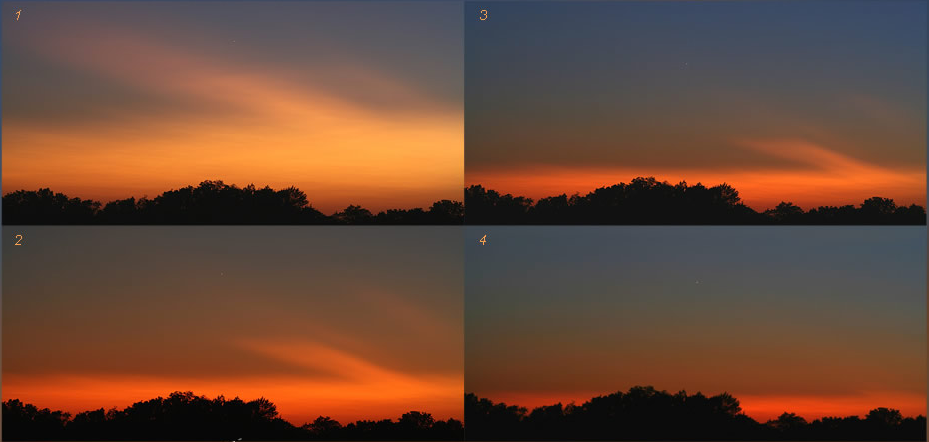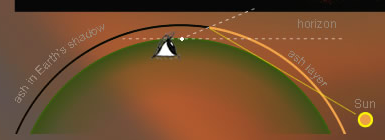Sunward Earth's Shadow
Sunward Earth's Shadow: Exploring the Phenomenon
When we think of the Earth's shadow, we often imagine it appearing in the east after sunset. However, there are instances where this shadow can be observed in the west as well. One such occurrence was captured in a series of stunning images by photographer Doug Zubenel in August 2008. These images reveal the Earth's shadow sweeping westward and downwards, gradually obscuring a volcanic twilight glow. This phenomenon is not only visually captivating but also offers an opportunity to delve deeper into the atmospheric optics at play.
In the images taken by Doug Zubenel, a layer of volcanic ash high in the atmosphere over the United States and Europe scattered sunlight, causing the shadow of the Earth to progressively diminish the glow. It is interesting to note that the Earth's shadow rises in the east, moves swiftly across the zenith, and then descends towards the west. The last photograph captured by Zubenel was when the sun was approximately 6.2° below the horizon. By employing trigonometry, we can estimate that the ash layer responsible for this unique atmospheric display was located at an altitude of around 50,000 feet in the stratosphere.
To gain a better understanding of the Sunward Earth's Shadow phenomenon, let us explore some key aspects:
-
Volcanic Ash: Volcanic eruptions can inject significant amounts of ash particles into the atmosphere. These particles can scatter sunlight, resulting in a range of optical effects, including the alteration of the Earth's shadow. The presence of volcanic ash in the stratosphere can cause unique atmospheric phenomena, adding complexity to our observations.
-
Sunset and Sunrise: The Earth's shadow is typically observed during twilight, shortly after sunset or before sunrise. This is when the sun is below the horizon, and its light interacts with the Earth's atmosphere, creating a gradient of colors and atmospheric phenomena. The Earth's shadow, in combination with other optical effects, contributes to the beauty and diversity of these twilight moments.
-
Path of the Earth's Shadow: The Earth's shadow follows a predictable path across the sky during twilight. It rises in the east, moves overhead at the zenith, and then descends towards the west. This trajectory is influenced by various factors, including the position of the observer, the time of year, and atmospheric conditions.
-
Atmospheric Optics: Atmospheric optics is a field of study that explores the behavior of light as it interacts with the Earth's atmosphere. It encompasses a wide range of phenomena, including the formation of rainbows, halos, mirages, and the Earth's shadow. By understanding the principles behind these phenomena, we can unravel the intricacies of our atmosphere and its impact on our visual experiences.
-
Trigonometry and Altitude Estimation: Trigonometry plays a crucial role in estimating the altitude of atmospheric layers and particles. By utilizing mathematical calculations based on the observed angles and distances, scientists can approximate the height at which certain atmospheric events occur. In the case of Zubenel's photographs, trigonometry allowed us to estimate the altitude of the volcanic ash layer responsible for altering the Earth's shadow.
-
Stratosphere: The stratosphere is a layer of the Earth's atmosphere located above the troposphere, extending from approximately 6 miles (10 kilometers) to 31 miles (50 kilometers) above the Earth's surface. It is characterized by its stability and contains the ozone layer. The presence of volcanic ash in the stratosphere can have far-reaching effects on weather patterns, climate, and atmospheric optics.
In conclusion, the Sunward Earth's Shadow phenomenon offers a captivating glimpse into the interplay between light, atmospheric particles, and our planet's shadow. Through the remarkable photographs captured by Doug Zubenel, we can appreciate the beauty and complexity of atmospheric optics. Exploring the influence of volcanic ash, the path of the Earth's shadow, and the role of trigonometry in altitude estimation allows us to unravel the intricacies of this mesmerizing natural phenomenon. By studying such events, we deepen our understanding of our atmosphere and its ever-changing dynamics.

The Earth's shadow sweeps westward and downwards to mask a volcanic twilight glow. Imaged in Kansas Aug '08 by Doug Zubenel. Image ©Doug Zubenel.

We usually look for the Earth's shadow in the east after sunset. However, Doug points out that here it appears in the west. A layer of volcanic ash high in the atmosphere over the USA and now, Aug 30, over Europe also scattered sunlight and the shadow of the earth progressivly snuffed out the glow. The shadow rises in the east, sweeps quickly across the zenith and then descends to the west. Doug's last picture (4) was taken when the sun was 6.2° below the horizon and some trigonometry shows that the ash layer was at an altitude of ~50,000 ft in the stratosphere.
Note: this article has been automatically converted from the old site and may not appear as intended. You can find the original article here.
Reference Atmospheric Optics
If you use any of the definitions, information, or data presented on Atmospheric Optics, please copy the link or reference below to properly credit us as the reference source. Thank you!
-
<a href="https://atoptics.co.uk/blog/sunward-earths-shadow/">Sunward Earth's Shadow</a>
-
"Sunward Earth's Shadow". Atmospheric Optics. Accessed on April 20, 2024. https://atoptics.co.uk/blog/sunward-earths-shadow/.
-
"Sunward Earth's Shadow". Atmospheric Optics, https://atoptics.co.uk/blog/sunward-earths-shadow/. Accessed 20 April, 2024
-
Sunward Earth's Shadow. Atmospheric Optics. Retrieved from https://atoptics.co.uk/blog/sunward-earths-shadow/.